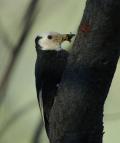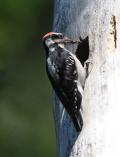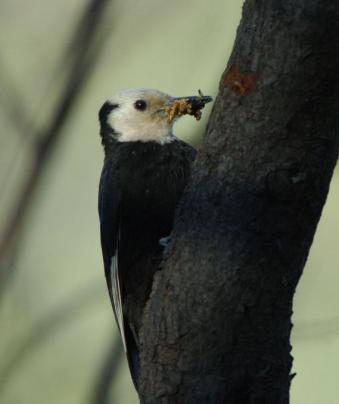Evaluating rates of nestling provisioning by adult birds provides insight into foraging strategies and reproductive effort. In most biparental avian species, both males and females provision the young, although this task is not always shared equally between sexes. In woodpeckers (Picidae), biparental care is thought to be necessary to successfully raise offspring, resulting in social monogamy for most woodpecker species. Unlike other avian groups, such as passerines, where females generally invest more than males in raising offspring, male woodpeckers contribute significantly to raising young by performing nocturnal incubation and brooding, and contribute equally to or greater than females in regard to nest sanitation and feeding of nestlings. However, parental roles in nestling provisioning and composition of prey brought to nestlings are not well-studied for North American woodpeckers. We studied nestling diets and the role of adult Hairy (Dryobates villosus) and White-headed woodpeckers (D. albolarvatus) in provisioning nestlings and nest sanitation during 2009–2011 in managed ponderosa pine (Pinus ponderosa) forests, Cascade Range, Washington.
We evaluated nestling diets of both Hairy and White-headed woodpeckers and sex-specific roles of adults when provisioning nestlings in ponderosa pine-dominated forests of the eastern Cascade Range, Washington. Specifically, our objectives were to:
(1) Determine if differences exist between the sexes in their rate of nestling provisioning and nest sanitation, and the size of prey delivered to nestlings for both species.
(2) Describe to the finest taxonomic level the diversity and frequency of prey fed to nestlings.
(3) Compare nestling diet overlap between the two species.
We conducted this study along the eastern slope of the Cascade Range in southern Kittitas and Yakima counties, Washington, from 2009–2011. Our study area contained 24 sites located on lands managed by Okanogan-Wenatchee National Forest (10 sites), Washington Department of Natural Resources (10 sites), and three private landowners (four sites). We used a 65ED spotting scope with a XW 10 eyepiece positioned 30–50 m from the nest cavity to record feeding observations during 2-hr time periods. During each observation period, we determined the age and number of nestlings, the sex of the parent delivering prey to the cavity nest, if fecal material was removed, the size and type of prey delivered, and the time elapsed between feeding visits.
This study was completed in 2011 and the results have been put into a manuscript which has been accepted for publication in the peer-reviewed Wilson Journal of Ornithology.
Status: Completed
05/01/2009 to 08/15/2011Project Manager
-
Jeff Kozma ,
Timber, Fish and Wildlife (TFW), Wildlife Biologist
509-865-5121 x6343




